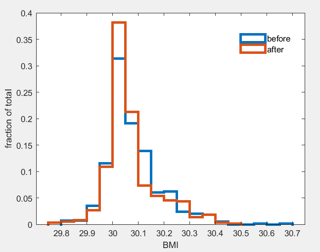Part 1: Distinction between paired and 2-sample data. For a graphical display of measurements Before and After treatment for one group of people, it is often best to plot differences. If you show Before and After scores in separate histograms, stripcharts, boxplots, or other graphic displays the paired observations are not evident. If every one of 200 subjects shows even a little decrease, that is strong evidence of an effect, even if may not be large enough to be important in practice. Depending on the binning, two separate histograms of Before and After BMIs may show little difference--or no difference at all.
Consider the fictitious paired data sampled below (using R).
set.seed(412)
x.b = rgamma(200,10, 1/3)
d = rnorm(200,-2,.25)
x.a = x.b + d
summary(x.b)
Min. 1st Qu. Median Mean 3rd Qu. Max.
11.53 22.58 28.29 29.84 36.48 54.93
summary(x.a)
Min. 1st Qu. Median Mean 3rd Qu. Max.
9.528 20.369 26.156 27.820 34.438 52.748
summary(d)
Min. 1st Qu. Median Mean 3rd Qu. Max.
-2.693 -2.204 -2.034 -2.020 -1.836 -1.209
Comparing the first two histograms is difficult (and pointless!). The third histogram shows the relevant information.

R code for figure above:
par(mfrow=c(1,3))
hist(x.b, prob=T, col="skyblue2", main="Before")
hist(x.a, prob=T, col="skyblue2", main="After")
hist(d, prob=T, col="skyblue2", main="Difference")
par(mfrow=c(1,1))
However, you use the word 'groups' in your question, so it is not entirely clear whether you have paired measurements on one group of subjects Before and After, or whether you have data for a Before group and for an independently chosen After group. So I will
discuss the case of data from independent groups also.
Part 2: Graphic displays of two-sample data. Various statisticians have different favorite graphical displays for showing differences between independent groups. Histograms are not among my personal favorites because information can be lost (or sometimes even distorted) by sorting observations into bins. Also, when histograms of two similar samples are plotted on the same axes, the interplay between them can be confusing. Even so, I imagine I can see more of the higher values in the Before (blue) group.
Consider the fictitious data below (200 subjects in each of two groups), sampled in R from two slightly different beta distributions. A nonparametric 2-sample Wilcoxon rank sum test shows a significant difference at the 5% level (nearly significant at the 1% level).
set.seed(2021)
x1 = 100*rbeta(100, 20, 80)
x2 = 100*rbeta(100, 20.5, 79.5)
wilcox.test(x1,x2)
Wilcoxon rank sum test with continuity correction
data: x1 and x2
W = 3954, p-value = 0.01063
alternative hypothesis:
true location shift is not equal to 0
However, I can imagine that by plotting the two histograms at left in the figure
below on the same axis that I might have trouble seeing this significant difference.
[R code for the figure is given below it.]
By contrast, the two boxplots seem to have different medians. The notches in the sides
of the boxes overlap only very slightly, roughly indicating that a two-sample nonparametric test might find a significant difference at the 5% level. [Admittedly this is cheating, by superimposing what may be test results on a graphic display, but even ignoring the notches, the medians do seem different compared with the spread of the data in the two groups.]
Moreover, ECDF plots often give a better clue as to the CDF of a population, than the clue histograms of give about the densities of the population distributions. This is particularly true for samples of small or moderate size. Also, comparing the ECDFs of the two groups it seems that observations in x2 (brown sample) tend to be than do observations in x1. (Thus the brown ECDF plots mostly below the blue one.) Sometimes one says that sample x2 'stochastically' dominates x1.
Consider

par(mfcol = c(2,2))
cutp = seq(10,38, by=4)
hist(x1, prob=T, br=cutp, col="blue")
hist(x2, prob=T, br=cutp, col="brown")
boxplot(x1,x2, notch=T, col=c("blue","brown"))
plot(ecdf(x1), col="blue")
lines(ecdf(x2), col="brown", lwd=2, pch="o")
par(mfcol = c(1,1))



